
The Cairngorm Mountain Railway, which opened in 2001, is the highest railway in the United Kingdom. The two-kilometre long funicular ascends the northern slopes of Cairn Gorm, the United Kingdom's sixth-highest mountain, serving the Cairngorm Mountain ski resort. The route and ski area are located within the Cairngorms National Park, the largest National Nature Reserve in Britain, located near Aviemore in the Highland council area of Scotland. A Doppelmayr 120-SSB funicular railway.
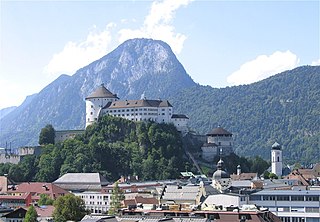
Kufstein is a town in the Austrian state of Tyrol, the administrative seat of Kufstein District. With a population of about 18,400, it is the second largest Tyrolean town after the state capital Innsbruck. The greatest landmark is Kufstein Fortress, first mentioned in the 13th century.

Ellmau is a municipality in the district of Kufstein in the Austrian region of Sölllandl. It lies 12 km southeast of Kufstein and 9 km west of Sankt Johann in Tirol. It is located at an elevation of 820 m above sea level. It was mentioned for the first time in the records in 1155 and is nowadays part of the Ski Welt skiing area.
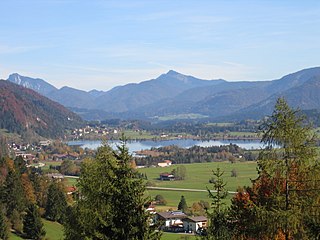
Walchsee is a municipality in the Austrian state of Tyrol in the Kufstein district. It is located in the lower Inn valley and belongs to the "Kaiserwinkl" and the "Untere Schranne".
The Funiculars of Lyon is a network of funicular railways in Lyon, France. Of the five lines once in existence, only the two routes on the Fourvière hill remain in operation, with the rest of the network now either closed, converted to road vehicle use, or integrated within the Lyon underground system.

Rail transport in Austria is mainly owned by the national rail company ÖBB. The railway network consists of 6,123 km, its gauge is 1,435 mmstandard gauge and 3,523 km are electrified.
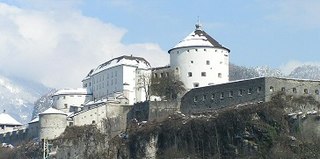
The Kufstein Fortress is the main landmark of Kufstein, a town in Tyrol, Austria. It is sometimes wrongly referred to as Geroldseck Fortress. It is on a hill commanding Kufstein proper. Kufstein Fortress is 507 metres (1,663 ft) above sea level.

The Montmartre Funicular is an inclined transport system serving the Montmartre neighbourhood of Paris, France, in the 18th arrondissement. Operated by the RATP, the Paris transport authority, the system opened in 1900, and was entirely rebuilt in 1935 and again in 1991.
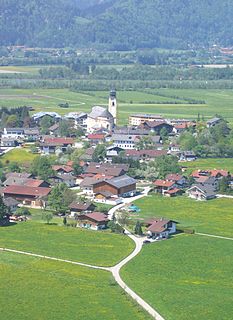
Ebbs is a municipality in the Kufstein district, Tyrol (Austria). The village is located in the Judicial district of Kufstein and in 2016 had a population of 5,480.

Kundl is a market town in the Kufstein district in the Austrian state of Tyrol.
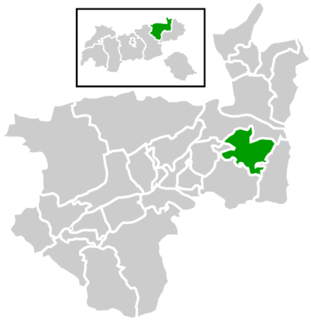
Scheffau am Wilden Kaiser is a municipality in the district Kufstein in the Austrian region of the Sölllandl. It is located 8.50 km southeast of Kufstein and 13 km northwest of Kitzbühel and has three subdivisions. The main source of income is summer tourism. The village has a public swimming area.
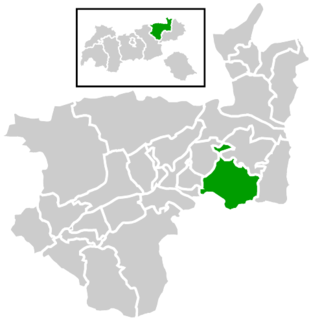
Söll is a municipality in the district of Kufstein in the Austrian region of Sölllandl. It is located 9 km south of Kufstein and 9 km east of Wörgl. The village consists of 25 subdivisions. The main sources of income are agriculture and tourism.

The Hofkirche is a Gothic church located in the Altstadt section of Innsbruck, Austria. The church was built in 1553 by Emperor Ferdinand I (1503–1564) as a memorial to his grandfather Emperor Maximilian I (1459–1519), whose cenotaph within boasts a remarkable collection of German Renaissance sculpture. The church also contains the tomb of Andreas Hofer, Tyrol's national hero.
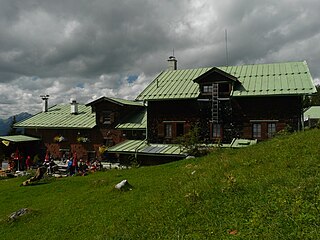
The Vorderkaiserfelden Hut is an alpine hut in the Kufstein district, Austria. It is located at 1,384 metres (4,541 ft) on the southwest slope of the Zahmer Kaiser below the Naunspitze and high above the Kaisertal valley in the Kaisergebirge mountain range. It has a good view over the Inn valley and Kufstein and across to the Mangfall Mountains and the Wilder Kaiser.

The Kaiser Mountains are a mountain range in the Northern Limestone Alps and Eastern Alps. Its main ridges – are the Zahmer Kaiser and south of it the Wilder Kaiser. The mountains are situated in the Austrian province of Tyrol between the town of Kufstein and the town of St. Johann in Tirol. The Kaiser Mountains offer some of the loveliest scenery in all the Northern Limestone Alps.

The Gubałówka Hill Funicular is located in Zakopane, Poland and ascends the Gubałówka mountain. It is operated by PKL, Polish Cable Lines or Polskie Koleje Linowe.

The Saltburn Cliff Lift is a funicular railway in Saltburn-by-the-Sea, Redcar and Cleveland in the ceremonial county of North Yorkshire, England. It provides access to Saltburn Pier and the seafront from the town. The cliff lift is the oldest operating water-balance cliff lift in the United Kingdom.
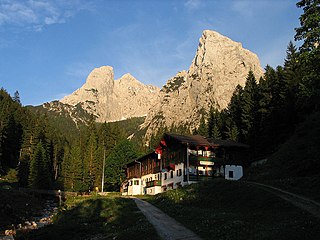
The Anton Karg Haus, formerly the Neue Hinterbärenbad Hut, is an Alpine club hut belonging to the Kufstein Section of the Austrian Alpine Club in the Kaisergebirge mountains in the Austrian state of Tyrol. The hut is named after the co-founder of the Kufstein Section, Anton Karg, who was the manager of the hut from 1888 and, from 1890 to 1919, the chairman of the Kufstein Branch of the Alpine Club.

The Tischofer Cave is a cave in the Kaisertal valley in the Kaisergebirge mountains in Austria. It was a locally important gathering place and weapons cache during the Tyrolean Rebellion in the Napoleonic Wars. The roughly 40 m (130 ft) long cave, which is about 8.5 m (28 ft) high at the entrance, was occupied by cave bears and other predators as shelter during the Paleolithic as evidenced by numerous excavated skeletal remains. Bone tools of paleo-human inhabitants made of cave bear bones and skulls discovered here and dated to about 27,000 - 28,000 years ago may be viewed in the local history museum in the fortress at Kufstein. That dating makes the Tischofer Cave the oldest known uncontested site of human occupation in Tyrol.

The Large Triumphal Carriage or Great Triumphal Car is a large 16th-century woodcut print by Albrecht Dürer, commissioned by the Holy Roman Emperor Maximilian I. The work was originally intended to be the central part of a 54 metres (177 ft) long print of a Triumphal Procession or Triumph of Maximilian, depicting Maximilian and his court entourage in a procession. This section shows the emperor in his triumphal car, and was part of a tradition depicting imaginary "triumphs" or real processions, such as royal entries.



















